TOMBSTONE
|
TOMBSTONE |
|
|
|
|
NAME: Tombstone COUNTY: Cochise ROADS: 2WD paved LEGAL INFO: T20S, R22E CLIMATE: Mild winter, hot summer BEST TIME TO VISIT: Anytime |
COMMENTS:
Many ghost towns in the area
that are worth seeing. Video available, see below. REMAINS: Many original buildings and cemetery. |
|
Tombstone's post office was established December 2, 1878 and has yet to be discontinued. Tombstone is the most famous of Arizona mining camps with its colorful history. Discovered by Ed Schieffelin in 1878, the mine went on to produce millions. Tombstone had over 15,000 residents at one time. Fires nearly caused the death of Tombstone twice but the town was resilient. Famous for the O.K. Corral shootout with the Earps and Boot Hill cemetery, Tombstone is well worth the visit! - GT Tombstone - "the Town Too Tough to Die". One day in 1877 the prospector Ed Schieffelin stand in Camp Huachuca and he looked on the mountains in the northeast. The rich colors of the mountains looked to him very promised and he decided to go there and dig a little. He toll that to the soldier who stand beside him and the soldier warned him about Apaches who controlled the area, and he say to him "All you'll find in those hills is your tomb-stone". In February 1878 decided Schieffelin at go alone on the search after his fortune. He found a rich silver ore (on the place were he was hiding in two nights for Apache Indians and in the memory what the solders tell him, he registered the two lots: "the Tombstone" and "the Graveyard". He decided that his brother Al shall see the ore and check the ore value, so he traveled all the way to Signal (now ghost town about 170 mile in airline from Tombstone). Brothers returned together with Signal assay Richard K.Gird, who saw the ore value, and he over talked the brothers to bee theirs partner. On the way back Ed found two places more with silver ore and registered the lots as "Lucky Cuss" (he called him self that) and "the Toughnut" (he counted that will be "a tough nut to crack"). 40 million dollars in silver (value of 1.7 billion dollars today) was the result from those and others mines in the area between 1880-1886. Tombstone who flourished under the hunt of silver in the beginning of 1880 was known as one of the most notorious and violence towns, - here was silver the king, - but anyway so was a Tombstone the most nice and cultural town in the West. The city had 4 church, school, two banks, newspaper ("The Epitaph"), one opera and about 15000 citizens. One big fire destroyed the Main Street in 1881 and in 1882, and every time was built up again. Ed Schieffelin left Tomb-stone and he traveled after a new adventure to Yukon. Even that story is told by Hollywood and by many historians, Tombstone was the place were man lived fast and died quickly. (Actually that were more dangerous to live in Charleston and Millville who were more violent that Tombstone). Post office opened on December 2, 1878 and is still not closed. The fight by OK Corral in 1881 is remembered as the mostly notorious fight in the history of the town. The mostly reason for the shooting were the fight for the political power in the new grounded Cochise County. On the one side was Sheriff Johny Behan and Clan-ton clan who run "moonshine ranch" with stolen cattle and Stage robberies. The (relative) good men were US Mars-hall Wyatt Earp, his brothers Virgil and Morgan, and the known alcoholic gunman "Doc" Holliday. In the afternoon on October 26 came Earp brothers and Holliday to corner of Fremont and 3th Street where five young members of Clanton gang were looking for possibility of fight. According the late explanation of Ikke Clanton, pushed Wyatt Earp his gun in Clantons baly (stomach) and yell "You son of a bitch, you can have a fight." Clanton turned around and run away, guns and rifle send lead away, and in about 30 seconds (Wyatt Earp's vitnes in the court) 3 of Clanton's men were dead and Virgil and Morgan were serious wounded. The story ended not here and people talked much about live and law in the borderland and in Tombstone. Earp brothers and Holliday were questened in the court and found not guilty. Two months later around midnight tried masked man to kill Virgil Earp, but they only invalided his arm for the rest of his live. Three months after that, one asian killed Morgan Earp. Wyatt Earp who worked outside the law to find the killer, killed 3 men who were suspected for the murder of his brother, and leaved Cochise County for ever. Because of the many killings almost every day, President Chester Arthur was ready to send military into the town when the troubles topped in 1882. Once ad the time were given 110 permits for serving the alcohol. Even that silver give possibility so the town build a serious theater, the town were nit known for his cultural live, but for the flying lead. After one hard period of rein in 1886, water was flooding into the mines who collapsed and that was end of mining. Charleston and Millville died and Tombstone were serious "wounded". The numbers of citizens dropped but the town survived. Mines started to open again in 1890 an those worked until after the change of the century, when a new flooding stopped the mining. When the town lost the title as County town to Bisbee, proclaimed the newspaper "Graham County Guardian": "Tombstone got his dead stitch". The pockets of silver in the mountains are changed to silver in the pockets by the tourists, and Tomb-stone is still in live and lives good as a tourist town by his history. Beside others, the restored Crystal Palace Saloon from 1879 were was the office of city Marshall Virgil Earp and Sheriff Johny Behan; and OK Coral witch became famous in one turbulence moment of shooting are open again. Allen Street (named after John Allen), once full with bars, casinos, bordells and Courthouse are restored. The original Cochise County Court-house build in 1882, including court hall and gallows are now "State Historic Park". In the northwest corner of Tombstone is famous Boothill graveyard. West of the city, behind Tomb-stone graveyard is one pyramid looking stone monument who marked Ed Schieffelin grave place, who wished to be buried on the place were he hide in two nights for Apaches short before he found the big silver ore. Bobby Zlatevski 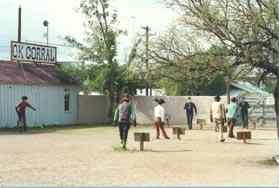 OK Corral Courtesy Dolores Steele 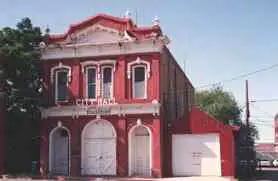 City Hall Courtesy Dolores Steele 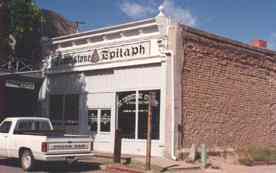 Tombstone Epitaph Courtesy Dolores Steele 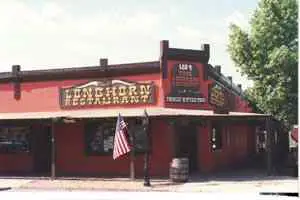 Longhorn - 1884 Courtesy Dolores Steele 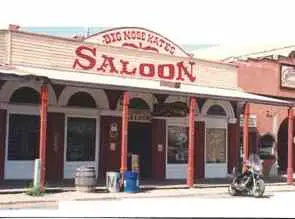 Big Nose Kates Saloon Courtesy Dolores Steele
|
|
|---|
|
|